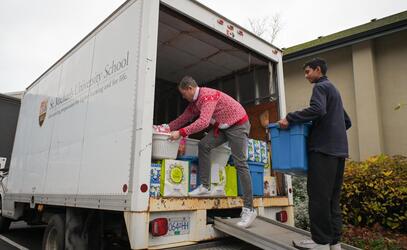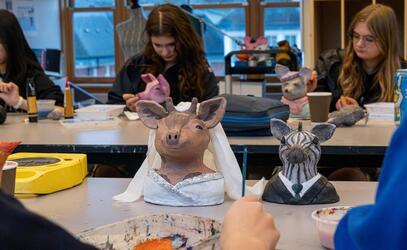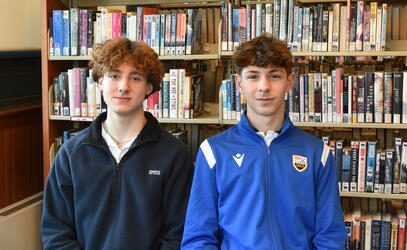The words “school spirit” have a universally understood definition related to building a unified identity as a school community. But defining school spirit, in practice, is a little harder to do. Its definition will vary depending on who you ask; where they’re from, what they’re involved in and what their experience has been like at the school.
And while defining school spirit is no doubt a challenging task, it’s one that our Prefect Council is tackling this month.
“When we first met as a Prefect Council during our Prefect Retreat, we brainstormed a few long-term goals we should attend to. One of them was promoting this idea of school spirit,” says John Sun, a Grade 12 student and member of the Prefect Council. “A couple of weeks ago, we were in this deep, complicated discussion about promoting school spirit and we were completely in the weeds, and [Director of the Senior School] Mr. Anderson stopped us and asked us, ‘What is school spirit? What are we trying to promote here?’ It caught us off guard and we realized we don’t actually know what school spirit is for our school.”
Inspired by projects Rev. Keven Fletcher has run in the past (where students write their responses to big life questions on large chalkboards), John suggested the Prefect Council could benefit from the same sort of cross-campus engagement to find out how students K-12 define school spirit.
Last week, John and his fellow Prefects set up chalkboards at the Junior and Middle School campuses asking two driving questions: “What does school spirit mean to you?” and “What does school spirit look like?”
For days, the Kindergarten through Grade 8 students contemplated the questions and thoughtfully wrote out their responses. Those chalkboards are now hung outside of the Chapel.
This week, the project to define school spirit also launched at the Senior School, and the chalkboards are now available for Grades 9-12 students to share their thoughts. Head of School Mr. Mark Turner, who very much supported the initiative, prefaced the project at the Senior School with a Chapel speech.
“School spirit, for me, is respect for each member of our community, and through each individual it's respect for the school as a whole. The important point there is that is starts with respect for one another,” Mr. Turner said in Chapel.
He also spoke about his recent trip to Thailand, where he met with school alumni and posed the same questions about defining school spirit to past students. He said that alumni answered with such responses as: believing in the importance of community, respecting others, healthy competition, trust, challenging ourselves and a spirit of positivity.
John says it has been really nice seeing students from all three schools participate and add their voice to the project.
“It’s been interesting to see just how the answers change from school to school. We have these very concrete ideas around community, leadership and service here; we teach how students need integrity and respect, and those are part of the education here and they shape you as you get older and more exposed to it,” John says. “At the Junior School level, all of the responses are still very raw and not filtered through that yet, so we got very tactile answers like 'School spirit means cheering on pizza moms’. As the students get older, though, you start to see answers like, ‘Respect for one another’. It’s been interesting seeing the diversity of answers.”
The next steps will be for the Prefect Council to analyze all the information that students, teachers and alumni have contributed. This project will help inform the students now (and hopefully in the future) as they work towards the goal of continuing to promote school spirit at SMUS.
“The whole purpose is to give the Prefects and all the administration a better idea of what school spirit means to everyone here. No doubt this information will be useful for the Prefects, who oversee student life, but also the council heads who have more hands-on, targeted goals for their councils and for administrators, too,” John says. “As a Prefect Council, we’re looking forward to even more cross-campus collaboration. We’ve realized that this whole initiative has been successful, and so we want to replicate things like this in the future that reaches and benefits all students, K-12.”


